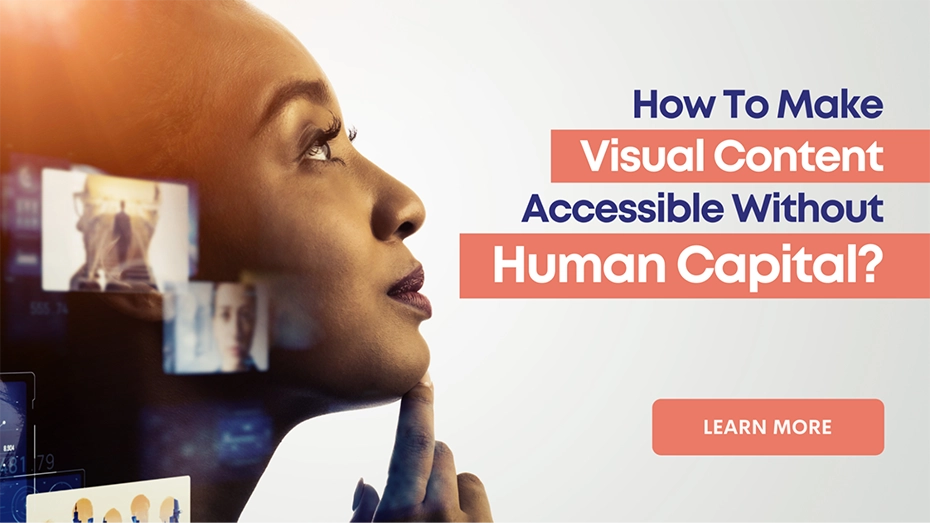The Importance Of Creating Accessible Visual Content
In the digital era where billions of people are consuming information online, organizations are constantly generating visual content to actively engage users.
With consumers being more socially aware, they want to invest their time in brands with shared values. Businesses creating content accessible by the visually impaired are able to reach out to a larger audience in a more meaningful way.
The reason that many small and medium-sized businesses (SMBs) are unable to create visual content that is accessible is due to the lack of resources available to them. In order to create an inclusive platform, businesses need to invest time and money in manually generating alt-text descriptions to make their content accessible.
By automating the process of generating alt-text descriptions, organizations can significantly increase their productivity while saving on costs and time.
According to an annual analysis by WebAim of more than one million homepages, it was found that one-third of the images were missing alternative text.
How Can Organizations Embrace Visual Accessibility
As the digital medium becomes the go-to preference for all communication and interactions, forward-thinking organizations must establish themselves as pioneers in providing accessible content to their viewers – potential employees, investors, and clients. The primary goal with content today is to achieve accessibility at scale. This requires organizations to develop infrastructure for creating accessible content without excessive human intervention and complex work processes. Here is how organizations can easily implement visual accessibility:
Identify
Organizations need to identify the key areas on their website where they want to ensure accessibility of visual content. By understanding the need to create a holistic experience for the visually impaired, organizations can make inclusive decisions to create accessible content right at the initial stages of design.
Assess
Organizations need to invest in solutions that will enable them to create accessible content more efficiently. Traditional methods that are expensive and require the involvement of many experts can be replaced by automated solutions, powered by artificial intelligence (AI), that are more efficient in generating accessible alt-text descriptions meeting compliance standards.
Implement
The next step for organizations to begin publishing accessible content without human capital is to implement the most viable automated solution. Upon the integration of an AI-powered solution, businesses will witness an increase in the generation of alt-text descriptions for their images while significantly saving on costs and time.
How Can Organizations Leverage Artificial Intelligence To Create Accessible Visual Content Without Excessive Human Capital
By leveraging advanced AI technology, organizations can generate alt-text descriptions that meet compliance standards for images of varying complexities accurately and efficiently.
With AI the need for human capital reduces as manual processes are now automated. By leveraging AI to perform the repetitive tasks to generate alt-text, organizations can create accessible content at a much faster rate and with minimal human interaction, therefore saving time and costs.
With an increase in the utilization of visual content, it is important for organizations with an online presence to make thoughtful organizational decisions to implement AI and create accurate accessible content in order to enable their visually impaired users to access information more efficiently.
Increases Productivity
By automating the process of generating alt-text descriptions, organizations can save on time, redirecting their resources to focus on core aspects of their roles, increasing productivity in turn.
Exponentially Saves Time And Costs
With automated AI-based scalable solutions, organizations can generate alt-text descriptions for high volumes of images at a much shorter turnaround time. This process meets compliance standards without human capital, helping businesses save significantly on both costs and time.
Creates An Inclusive User Experience
In order to create an accessible user experience (UX), organizations need to make web design decisions that meet web accessibility standards. With the help of automated processes that leverage deep learning, businesses can meet compliance standards more effectively.
Organizations that design their website while catering to the needs of the visually impaired by providing accessible content, create an inclusive user experience and build a sense of trust that motivates users to return to their website.
Meets Compliance Standards
By leveraging AI-powered solutions, businesses can generate alt-text descriptions more efficiently, ensure that the visually impaired are able to access the visual content with the help of their assistive technology, and meet the Web Content Accessibility Guidelines (WCAG) compliance standards.
Invicta As a Tool To Make Visual Content Accessible
With our AI-powered solution Invicta, universities, publishers, and businesses can automate the process of generating accurate alt-text descriptions in full compliance to Section 508 and WCAG accessibility guidelines for large volumes of images of varying complexities.
Key Features of Invicta:
Accurate long descriptions for STEM and accounting images
Automated PDF remediation and website accessibility
One-click accessibility, easy to learn, use, and collaborate
An efficient, affordable, and high-quality solution
With AI-based algorithms created specifically for STEM and accounting streams, alt-text for images can be generated at the click of a button. As the AI algorithm is trained extensively, the generated content has very high accuracy and consistency. Additionally, Invicta has the human touch of Subject Matter Experts (SMEs) reviewing all the machine-generated content.
By integrating Invicta, organizations can automate their process of creating accessible visual content with reduced human capital in order to save time and costs while creating an inclusive user experience, and catering to the needs of the visually impaired.
Our one-stop solution Invicta uses real-time AI technology to automate the process of generating high-quality and compliant accessible content, while greatly saving on costs and time. Seamlessly integrate Invicta into your organization and automate your process of generating accessible visual content. Learn more about us here.
Bridge the Gap with Inclusive Video Content
Experience Speed, Accuracy, and Affordability with Our End-to-End Accessibility Services.
